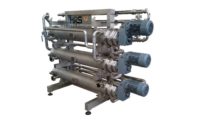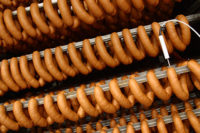Tech | Supplier's Perspective
Ensuring food safety should not increase food waste

The first duty of any food or drink manufacturer is to supply consumers with safe products. While it is essential to maintain good equipment hygiene through the use of effective protocols, such as clean-in-place (CIP) systems, it is also economically important that perfectly usable product is not discarded as part of routine cleaning operations.
CIP systems for processing equipment, such as pipework, heat exchangers, pasteurizers, fillers, pumps, etc, offer a number of advantages over manually disassembling, cleaning, checking and then re-assembling plant. Not only are they much quicker, and less labor intensive, but they also reduce costs and allow more frequent and therefore more effective routine cleaning of systems to be carried out. There are many different types of mechanical and automatic cleaners employed in the food industry, but before any CIP can be carried out, as much product as possible must be removed from the equipment to be cleaned.
Traditional flushing and ‘pigging’ systems (which physically push product through the system) often result in the loss of product, the value of which can soon add up: some sources suggest supply chain waste could be worth as much as $24 billion a year to the U.S. economy1. The challenge is therefore to implement effective and rigorous CIP regimes in a way which minimizes the loss or degradation of product. This is where two recently developed systems from HRS Heat Exchangers come in.
The first development uses the design of the HRS R Series of scraped surface heat exchangers to physically remove product without the need for additional pigging systems. The R Series has a unique design which enables high viscosity products to be pumped with reduced back pressure and lower energy use. The helical spiral which scrapes the surface of the tubes to prevent fouling in normal use, can also be run in reverse; thereby enabling valuable product to be recovered prior to routine cleaning or product changeover. This means that the HRS R Series can be emptied of the majority of product without the need for additional pumps or pressure systems, reducing both capital and running costs.
The second development is the HRS Product Recovery System. This combines continual monitoring of a set parameter (for example Brix, pH or viscosity) with the three-way valve technology employed in every HRS pasteurizer or sterilizer. Working together, these two systems ensure that all product which meets the set parameters is utilized, and only that which falls outside (for example, that diluted prior during CIP) is discarded. Furthermore, such monitoring helps to validate the effectiveness of CIP and ensures that following a cleaning cycle, only product that meets specification is allowed to proceed.
As well as the financial benefits associated with recovering more product, further advantages include a reduction in the amount of waste generated, which in turn decreases disposal costs such as storage, transport and treatment. These various savings add up and mean that this type of equipment rapidly pays for itself. Crucially however, the effectiveness of CIP and the requirements of HACCP analysis continue to be met, ensuring food safety remains paramount. NP
1 Calculation based on total U.S. food sales of $1,459 billion in 2014 representing 75% of primary food production. See https://www.statista.com/statistics/207856/us-total-food-sales-since-1990/
Looking for a reprint of this article?
From high-res PDFs to custom plaques, order your copy today!








